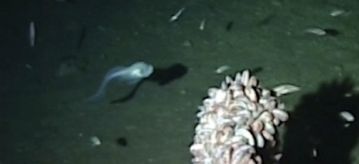Ever since moving back to the Detroit area nearly seven years ago, one thing I’ve noticed is a propensity for our local news outlets to go full pseudoscience from time to time. I’m not sure why, other than perhaps that it attracts eyeballs to the screen, but, in reality, most of these plunges into pseudoscience and quackery are so poorly done that I find it hard to believe that even believers find them interesting. For example, back in 2008, I discussed a particularly dumb story aired by our local NBC affiliate WDIV entitled Orbs: Myth or Real?, which, not having started my new job yet, I gleefully deconstructed at the time. For those of you who aren’t familiar with “spirit orbs,” which are claimed to be the spirits of the dead but almost always represent photography artifacts, such as lens flare, dust on the lens catching light, or similar things that can lead to light blobs showing up on photos.
Also at the time, an investigative reporter named Steve Wilson was still spreading antivaccine mercury militia pseudoscience through the local ABC affiliate WXYZ, leading me to wonder whether he was a a legitimate investigative reporter or an antivaccine propagandist. Indeed, his antivaccine propaganda dressed up as news reports was spreading to a national audience, thanks to Age of Autism and other antivaccine groups. Actually, he was both. When it came to politics and corruption, he was a decent investigative reporter; indeed, his exposes of our utterly corrupt former mayor Kwame Kilpatrick’s were, in retrospect, prescient, and provoked Kilpatrick to take his revenge. When it came to vaccines, he had completely swallowed the Kool Aid that claims that mercury in vaccines caused an autism epidemic. I’m not sure if it was the antivaccine reporting or other issues, but Wilson’s contract was, fortunately, not renewed in in 2010.
In any case, given the record of local news stations when it comes to credulously reporting medical pseudoscience (and pseudoscience in general), I would normally not be surprised to see a report on a local station in which quackery is presented as real medicine. (Heck, I deconstructed just such a story a year and a half ago.) I was more surprised (but probably shouldn’t have been) to see such a report in our local newspaper, the Detroit Free Press complete with a video for the online story. The story is by Jennifer Dixon and is entitled Veterinarian offers alternative approach to healing. The story is even showing up in statewide media. Ms. Dixon is an investigative reporter, but in this case hers was a massive fail to do even the most basic investigation, so much so that one wonders if we have another Steve Wilson in the making.
Basically, it’s so credulous that it might as well be an advertisement for a veterinarian named Dr. Loren Weaver, who subjects animals to a variety of nonsensical treatments:
The video is painful to watch, so steeped in mystical woo is it. It’s hard to believe that this sort of rot made it even on the air even from a local news station, but it did. The text begins:
Dr. Loren Weaver practices “energy medicine” on dogs, horses and the occasional cat.
“There’s a big transfer of energy from me to the dogs, from the dogs to me, me to the horses and the horses back to me. That’s what makes this work is that transfer of energy,” the veterinarian said. “That’s what I pass through with my hands.”
He said that energy, or Chi, is carried through 12 meridians, or channels, in the body.
“I don’t ask someone to believe it exists,” he said. “If you let me work on your animal, I can show you how it works.”
His patients’ owners are believers.
Let’s get one thing straight right here, right now. “Energy medicine” is quackery. It’s mystical mumbo-jumbo with no basis in science. Reiki, for instance, the most common form of “energy medicine” is basically faith healing in which Eastern mystical beliefs replace Christian beliefs as the religious basis for belief that laying on hands can heal. It’s “The Secret“-level wishful thinking, and, unfortunately, reiki for Fido is becoming more common.
Of course, what Weaver describes as his “energy medicine” doesn’t sound like reiki. He doesn’t invoke the “universal source” as the source of the healing energy but rather seems to be claiming that he can manipulate animals’ “energy fields.” That sounds a lot more like “healing touch” (HT) or “therapeutic touch” (TT) another pseudoscientific mystical modality that is, unfortunately, all too commonly practiced in hospitals and is equally ridiculous as reiki. I like to say that it’s so ridiculous that even an 11-year-old girl could design a controlled study that demonstrated that TT practitioners cannot even sense a human “energy field,” much less manipulate one. This is not surprising, given that what TT practitioners mean by “energy” and what scientists mean by “energy” (to put it simply, the capacity of a physical system to perform work) are not even related by coincidence. Even with the most sophisticated and sensitive instruments, science has never been able to find anything like these “energy fields” around humans or animals that can be manipulated in the way that people like Dr. Weaver claim. Basically, energy medicine is prescientific vitalism infused with a heavy dose of religion. That is why I consider it quackery.
In any case, it turns out that Dr. Weaver is a veterinarian and a chiropractor. As I and others have pointed out before, basically any form of alternative medicine to which humans are subjected is also used in animals because, well, I guess we humans can’t help ourselves. We have to subject our furry, feathered, and scaly friends to the same sort of prescientific and pseudoscientific nonsense that we subject ourselves to. Hence, we see travesties, such as turtles and owls getting needles stuck into them and ducks and Basset hounds having their spines adjusted. Not surprisingly, Dr. Weaver is heavily into both chiropractic (being a chiropractic veterinarian) and acupuncture, both of which are on full display in this story.
Weaver even goes full Palmer on us and talks about the “innate intelligence” (although he doesn’t call it that) flowing from the brain through the nervous system and how anything impeding that flow will cause problems. Meanwhile, we are treated to images of Weaver doing spine adjustments on dogs, who most definitely do not appear to be enjoying it, as at least one of them has to be held and jerks as if in pain when Weaver does a lower spinal adjustment. One dog, a Dachsund named Rocky, is shown trying to bite Weaver as he adjusts his spine, all while his owner exults about how fantastic Rocky is doing for his slipped disc ever since Dr. Weaver started treating him. Of course, in the case of actual pathology, such as a disc problem, it is possible that spinal manipulation might be of some benefit, or, as is the case in humans, the course could be resolution in many cases. After all, from what I’ve observed we apear not to operate on herniated discs nearly as often as we used to.
Later in the video, Weaver is shown sticking needles into dogs, most of whom most definitely appear not to be liking it at all, as they all flinched as the needles were placed and had to be held to keep from biting at them. Meanwhile, he pontificates on traditional Chinese medicine (TCM) and how TCM teaches that disease is due to “blockages” of qi that can be resolved using acupuncture. Doesn’t Weaver know that TCM is a retconning of the actual history of Chinese folk medicine perpetrated by Chairman Mao Zedong back in the 1950s? Apparently not:
Weaver has been a veterinarian for 34 years and has been practicing acupuncture and chiropractic medicine for the last 26 years. He was first exposed to acupuncture while living in Kenya and saw how it helped horses in pain.
“It worked, and the horses relaxed and felt better,” Weaver said. When he returned to the U.S., he began studying acupuncture, which he uses for pain relief and back problems. He then immersed himself in chiropractic medicine. The son of a farmer who saw a chiropractor for his back, Weaver said he was exposed to chiropractic medicine as a child.
“When I started, no one was doing chiropractic,” Weaver said.
How does he know it helped? Proponents of alternative medicine will claim that quackery like acupuncture “works” in animals because it couldn’t possibly be due to placebo effects, but they are only sort of correct. The reason is that the only way we can know what animals are feeling is through the observations of humans, who interpret those observations as the animal either being in pain or getting better. Thus, placebo-like effects can occur in animals, but in reality they are a result of a change in perception of the animal’s condition by the owners, who expect results and, after treatment, look for results. If they believe acupuncture will work, often they report results. It’s difficult enough to quantify pain reliably in humans; in animals, it’s even harder. Add to that the tendency of most conditions to regress to the mean or to slowly improve, and, if the acupuncture or chiropractic adjustment is performed as improvement is beginning or around the time when the symptoms are at their worst (which is often the time when treatment will be sought), then it can appear that the treatment “worked.” There appears to be a phenomenon in veterinary medicine known as caregiver placebo effects, which appears to be a real phenomenon. Indeed, frequently, there is little or no correlation between owner-reported observations of animal pain and objective measures.
All of this explains why Dr. Weaver can have so many glowing testimonials about the efficacy of his methods, some of which are presented in this story. Unfortunately, our intrepid “investigative reporter” didn’t actually investigate. Instead, she produced an advertisement for Dr. Weaver, chiropractic veterinary medicine, and the use of TCM in animals. I realize that local reporters are often assigned human interest stories like this. People love their pets, and the story of an appealing, warm and cuddly vet who seems to be “working miracles” is a very tempting story to do. Everybody loves a story like this, particularly animal lovers, except, of course, “nasty” buzzkill skeptics like myself who, upon seeing a story like this, can’t help but look deeper.
from ScienceBlogs http://scienceblogs.com/insolence/2014/12/30/adventures-in-bad-veterinary-medicine-reported-by-the-local-media-year-end-edition/
Ever since moving back to the Detroit area nearly seven years ago, one thing I’ve noticed is a propensity for our local news outlets to go full pseudoscience from time to time. I’m not sure why, other than perhaps that it attracts eyeballs to the screen, but, in reality, most of these plunges into pseudoscience and quackery are so poorly done that I find it hard to believe that even believers find them interesting. For example, back in 2008, I discussed a particularly dumb story aired by our local NBC affiliate WDIV entitled Orbs: Myth or Real?, which, not having started my new job yet, I gleefully deconstructed at the time. For those of you who aren’t familiar with “spirit orbs,” which are claimed to be the spirits of the dead but almost always represent photography artifacts, such as lens flare, dust on the lens catching light, or similar things that can lead to light blobs showing up on photos.
Also at the time, an investigative reporter named Steve Wilson was still spreading antivaccine mercury militia pseudoscience through the local ABC affiliate WXYZ, leading me to wonder whether he was a a legitimate investigative reporter or an antivaccine propagandist. Indeed, his antivaccine propaganda dressed up as news reports was spreading to a national audience, thanks to Age of Autism and other antivaccine groups. Actually, he was both. When it came to politics and corruption, he was a decent investigative reporter; indeed, his exposes of our utterly corrupt former mayor Kwame Kilpatrick’s were, in retrospect, prescient, and provoked Kilpatrick to take his revenge. When it came to vaccines, he had completely swallowed the Kool Aid that claims that mercury in vaccines caused an autism epidemic. I’m not sure if it was the antivaccine reporting or other issues, but Wilson’s contract was, fortunately, not renewed in in 2010.
In any case, given the record of local news stations when it comes to credulously reporting medical pseudoscience (and pseudoscience in general), I would normally not be surprised to see a report on a local station in which quackery is presented as real medicine. (Heck, I deconstructed just such a story a year and a half ago.) I was more surprised (but probably shouldn’t have been) to see such a report in our local newspaper, the Detroit Free Press complete with a video for the online story. The story is by Jennifer Dixon and is entitled Veterinarian offers alternative approach to healing. The story is even showing up in statewide media. Ms. Dixon is an investigative reporter, but in this case hers was a massive fail to do even the most basic investigation, so much so that one wonders if we have another Steve Wilson in the making.
Basically, it’s so credulous that it might as well be an advertisement for a veterinarian named Dr. Loren Weaver, who subjects animals to a variety of nonsensical treatments:
The video is painful to watch, so steeped in mystical woo is it. It’s hard to believe that this sort of rot made it even on the air even from a local news station, but it did. The text begins:
Dr. Loren Weaver practices “energy medicine” on dogs, horses and the occasional cat.
“There’s a big transfer of energy from me to the dogs, from the dogs to me, me to the horses and the horses back to me. That’s what makes this work is that transfer of energy,” the veterinarian said. “That’s what I pass through with my hands.”
He said that energy, or Chi, is carried through 12 meridians, or channels, in the body.
“I don’t ask someone to believe it exists,” he said. “If you let me work on your animal, I can show you how it works.”
His patients’ owners are believers.
Let’s get one thing straight right here, right now. “Energy medicine” is quackery. It’s mystical mumbo-jumbo with no basis in science. Reiki, for instance, the most common form of “energy medicine” is basically faith healing in which Eastern mystical beliefs replace Christian beliefs as the religious basis for belief that laying on hands can heal. It’s “The Secret“-level wishful thinking, and, unfortunately, reiki for Fido is becoming more common.
Of course, what Weaver describes as his “energy medicine” doesn’t sound like reiki. He doesn’t invoke the “universal source” as the source of the healing energy but rather seems to be claiming that he can manipulate animals’ “energy fields.” That sounds a lot more like “healing touch” (HT) or “therapeutic touch” (TT) another pseudoscientific mystical modality that is, unfortunately, all too commonly practiced in hospitals and is equally ridiculous as reiki. I like to say that it’s so ridiculous that even an 11-year-old girl could design a controlled study that demonstrated that TT practitioners cannot even sense a human “energy field,” much less manipulate one. This is not surprising, given that what TT practitioners mean by “energy” and what scientists mean by “energy” (to put it simply, the capacity of a physical system to perform work) are not even related by coincidence. Even with the most sophisticated and sensitive instruments, science has never been able to find anything like these “energy fields” around humans or animals that can be manipulated in the way that people like Dr. Weaver claim. Basically, energy medicine is prescientific vitalism infused with a heavy dose of religion. That is why I consider it quackery.
In any case, it turns out that Dr. Weaver is a veterinarian and a chiropractor. As I and others have pointed out before, basically any form of alternative medicine to which humans are subjected is also used in animals because, well, I guess we humans can’t help ourselves. We have to subject our furry, feathered, and scaly friends to the same sort of prescientific and pseudoscientific nonsense that we subject ourselves to. Hence, we see travesties, such as turtles and owls getting needles stuck into them and ducks and Basset hounds having their spines adjusted. Not surprisingly, Dr. Weaver is heavily into both chiropractic (being a chiropractic veterinarian) and acupuncture, both of which are on full display in this story.
Weaver even goes full Palmer on us and talks about the “innate intelligence” (although he doesn’t call it that) flowing from the brain through the nervous system and how anything impeding that flow will cause problems. Meanwhile, we are treated to images of Weaver doing spine adjustments on dogs, who most definitely do not appear to be enjoying it, as at least one of them has to be held and jerks as if in pain when Weaver does a lower spinal adjustment. One dog, a Dachsund named Rocky, is shown trying to bite Weaver as he adjusts his spine, all while his owner exults about how fantastic Rocky is doing for his slipped disc ever since Dr. Weaver started treating him. Of course, in the case of actual pathology, such as a disc problem, it is possible that spinal manipulation might be of some benefit, or, as is the case in humans, the course could be resolution in many cases. After all, from what I’ve observed we apear not to operate on herniated discs nearly as often as we used to.
Later in the video, Weaver is shown sticking needles into dogs, most of whom most definitely appear not to be liking it at all, as they all flinched as the needles were placed and had to be held to keep from biting at them. Meanwhile, he pontificates on traditional Chinese medicine (TCM) and how TCM teaches that disease is due to “blockages” of qi that can be resolved using acupuncture. Doesn’t Weaver know that TCM is a retconning of the actual history of Chinese folk medicine perpetrated by Chairman Mao Zedong back in the 1950s? Apparently not:
Weaver has been a veterinarian for 34 years and has been practicing acupuncture and chiropractic medicine for the last 26 years. He was first exposed to acupuncture while living in Kenya and saw how it helped horses in pain.
“It worked, and the horses relaxed and felt better,” Weaver said. When he returned to the U.S., he began studying acupuncture, which he uses for pain relief and back problems. He then immersed himself in chiropractic medicine. The son of a farmer who saw a chiropractor for his back, Weaver said he was exposed to chiropractic medicine as a child.
“When I started, no one was doing chiropractic,” Weaver said.
How does he know it helped? Proponents of alternative medicine will claim that quackery like acupuncture “works” in animals because it couldn’t possibly be due to placebo effects, but they are only sort of correct. The reason is that the only way we can know what animals are feeling is through the observations of humans, who interpret those observations as the animal either being in pain or getting better. Thus, placebo-like effects can occur in animals, but in reality they are a result of a change in perception of the animal’s condition by the owners, who expect results and, after treatment, look for results. If they believe acupuncture will work, often they report results. It’s difficult enough to quantify pain reliably in humans; in animals, it’s even harder. Add to that the tendency of most conditions to regress to the mean or to slowly improve, and, if the acupuncture or chiropractic adjustment is performed as improvement is beginning or around the time when the symptoms are at their worst (which is often the time when treatment will be sought), then it can appear that the treatment “worked.” There appears to be a phenomenon in veterinary medicine known as caregiver placebo effects, which appears to be a real phenomenon. Indeed, frequently, there is little or no correlation between owner-reported observations of animal pain and objective measures.
All of this explains why Dr. Weaver can have so many glowing testimonials about the efficacy of his methods, some of which are presented in this story. Unfortunately, our intrepid “investigative reporter” didn’t actually investigate. Instead, she produced an advertisement for Dr. Weaver, chiropractic veterinary medicine, and the use of TCM in animals. I realize that local reporters are often assigned human interest stories like this. People love their pets, and the story of an appealing, warm and cuddly vet who seems to be “working miracles” is a very tempting story to do. Everybody loves a story like this, particularly animal lovers, except, of course, “nasty” buzzkill skeptics like myself who, upon seeing a story like this, can’t help but look deeper.
from ScienceBlogs http://scienceblogs.com/insolence/2014/12/30/adventures-in-bad-veterinary-medicine-reported-by-the-local-media-year-end-edition/












